HEAD
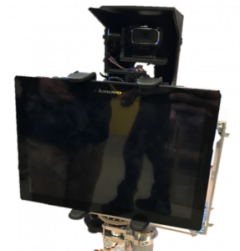
iTAD head model
Goal: The head is the main communication and interaction platform for end-users. Our goal is to facilitate the user experience and making it accessible. End-users see remote operators through the tablet screen. The camera is mounted above the tablet screen which shows the video feed of the remote operator. The centralized head structure mimics eye-level communication. The camera and tablet pan and tilt functions allows users to comfortably communicate with people at different heights – ex. an individual in a wheelchair or bed.
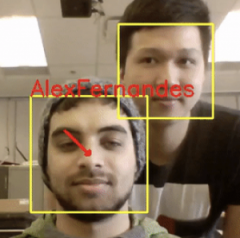
Facial recognition software
Facial Recognition
Facial recognition allows the camera to automatically move to center on the largest detected face (displacement shown by the red arrow vector), even as the face moves, to facilitate natural, eye-level conversations without the operator having to constantly refocus the camera as the end user moves. This feature also accommodates end-users that are unable to remain still for an extended period of time.
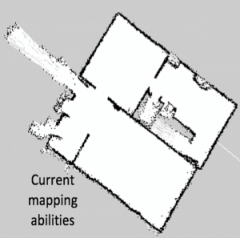
LiDAR mapping
Autonomous Navigation
The LiDAR (Light Detection and Ranging) sensor is mounted at the very top to allow for autonomous navigation. The LiDAR sensor maps iTAD’s surroundings, identifying where it is and calculating a path to get to its destination autonomously, by referencing a larger map of the environment. The image above shows a map created using the LiDAR sensor of a house floor.
FRAME
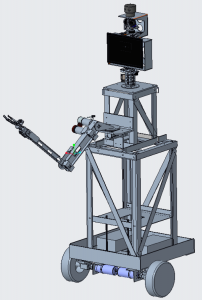
iTAD frame model
Goal
iTAD’s frame is designed to minimize iTAD’s footprint based on surveying size requirements in hospitals. iTAD’s main frame houses the internal electronics and batteries. The frame’s sturdy design allows for safe long-term use. The frame is fashioned as to be accessible; to not create barriers for individuals surrounding iTAD.
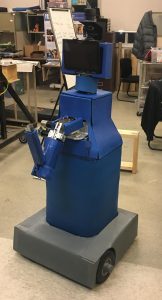
Shell prototype
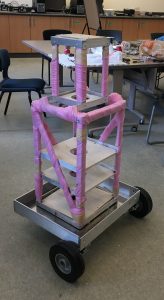
Frame Prototype
Manufacturing & Shell
The frame was manufactured and tested for safety and stability. It features easy to access shelves for electronics, as well as, built in wiring management system to ensure safe and organized wire management. A soft, friendly-looking shell was designed and built. This shell was focused on ensuring a human-friendly and professional product through curves and fashionable colour scheme. It also enhances the safety of the product by padding sharp edges of the frame.
ARM
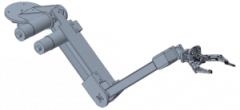
Goal
The arm enables iTAD to interact with its surroundings for an enhanced communication experience. Controlling the arm is made to easy by allowing the user to accurately position the gripper by toggling the main controller. The arm allows iTAD to act in an assistive role to help a person with a disability by lifting small objects, moving IV poles, pressing buttons etc. iTAD’s arm allows iTAD to navigate autonomously by being able to access doorways and press elevator buttons.
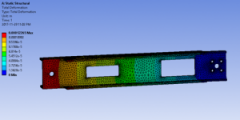
FEA analysis of arm’s upper linkage
Testing
It was crucial to verify that iTAD’s mechanical components will be able to sustain all loads applied. Stress analysis of most components was performed when operating in different scenarios.
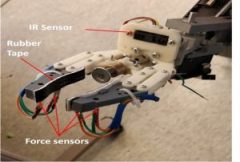
iTAD gripper
Gripper
The gripper is able to firmly grasp objects of different sizes and surface finishes. In order to do so the gripper is equipped with pressure sensors, infrared (IR) proximity sensors and a rubber grip. The gripper can be further instrumented to assist doctors with patient check-ups such as the addition of sensors like a pulse oximeter
DRIVETRAIN
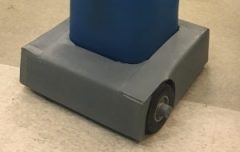
Base of iTAD
Goal
The differential drivetrain mechanism enables iTAD to be mobile. The low noise, high-traction and efficient drivetrain allows the end-user to effortlessly navigate iTAD using a controller. The drivetrain is sized to be able to easily fit through doorways of hospitals and independent living facilities. Ultrasound sensors can be installed in iTAD’s base for the collision avoidance system, which guarantees that iTAD is operating safely, especially during autonomous navigation.
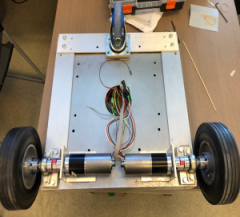
Built prototype
Construction
The design consists of two rubber wheels powered by two brushless DC motors and one castor wheel. High-quality motors Maxon motors were selected to extend iTAD’s durability. The drivetrain structure allows for stable and smooth navigation. As with other mechanical components used in iTAD, detailed engineering drawings of the system was developed to allow for the machining of parts.
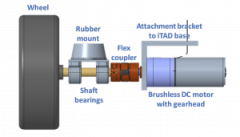
Model of suspension system
Suspension System
The proposed design for the compact suspension system enables iTAD to navigate different indoor terrain while minimizing vibrations which can result in a shaky video feed and damage to mechanical and electrical components. The suspension system consists of a vibration dampening mount. Bearings and couplers along the shaft allow for effective torque transfer without damaging the rotating motor shaft.
